Termite inspections are essential for safeguarding your home against potential damage by detecting infestations early and evaluating structural weaknesses. By investing in regular inspections, homeowners can avoid expensive repairs and maintain their property’s value. Understanding the various treatment options available, such as liquid termiticides and baiting systems, is crucial for effectively addressing any infestations that may arise.
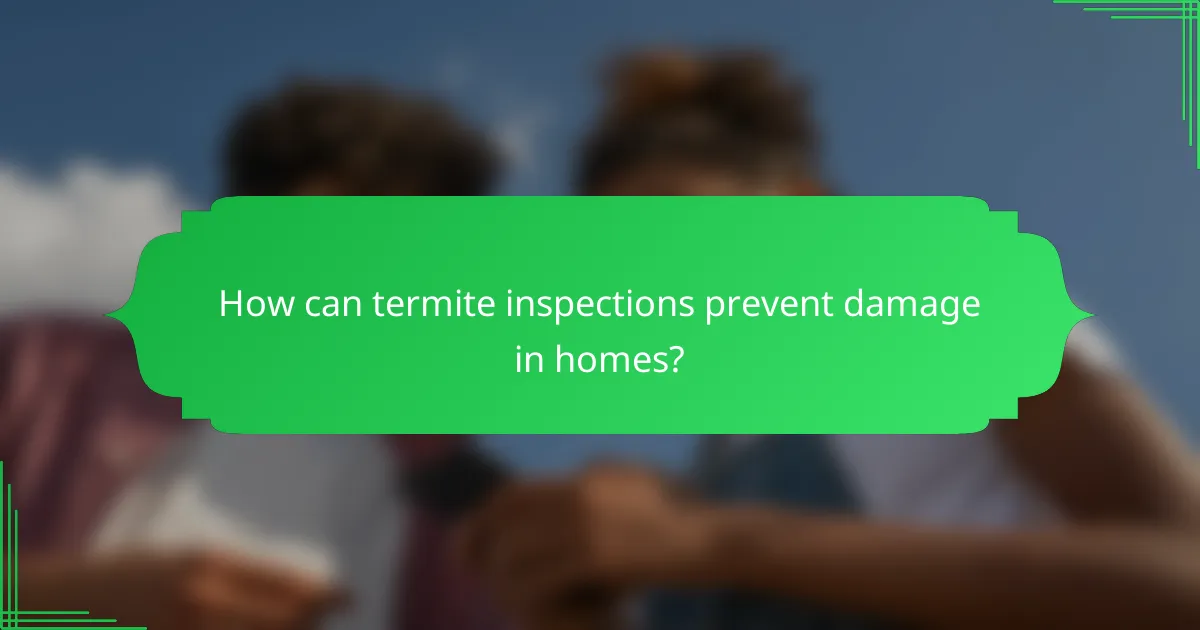
How can termite inspections prevent damage in homes?
Termite inspections are crucial for preventing damage in homes by identifying infestations early and assessing structural vulnerabilities. Regular inspections can save homeowners from costly repairs and protect their property value.
Early detection of termite infestations
Early detection of termite infestations allows homeowners to address issues before they escalate into significant damage. Inspections typically involve checking for signs such as mud tubes, discarded wings, and hollow-sounding wood.
Homeowners should schedule inspections at least once a year, especially in areas prone to termite activity. This proactive approach can help catch infestations when they are still manageable, potentially saving thousands in repair costs.
Identifying structural vulnerabilities
Identifying structural vulnerabilities during a termite inspection helps homeowners understand where their property may be at risk. Inspectors evaluate areas like basements, crawl spaces, and wooden structures for weaknesses that could attract termites.
Common vulnerabilities include moisture issues, wood-to-soil contact, and poor ventilation. Addressing these problems can significantly reduce the likelihood of termite infestations and prolong the life of the home.
Regular maintenance recommendations
Regular maintenance is essential for preventing termite damage. Homeowners should keep gutters clean, ensure proper drainage, and seal any cracks in the foundation to minimize moisture accumulation.
Additionally, consider using treated wood for outdoor structures and maintaining a barrier between soil and wooden elements. These practices can enhance the home’s defenses against termites and reduce the need for extensive treatments later on.
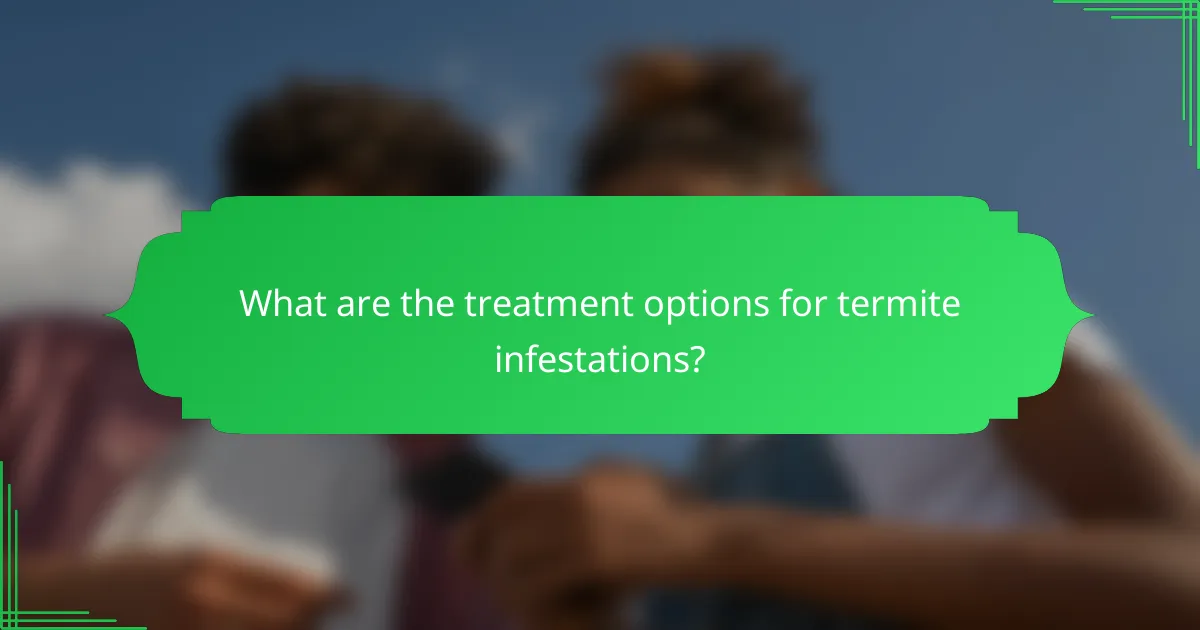
What are the treatment options for termite infestations?
There are several effective treatment options for termite infestations, including liquid termiticides, baiting systems, and fumigation services. Each method has its own advantages and considerations, making it essential to choose the right approach based on the severity of the infestation and the specific circumstances of your property.
Liquid termiticides
Liquid termiticides are chemical solutions applied to the soil around a property to create a barrier that prevents termites from entering. These treatments can be effective for both preventative measures and active infestations. It’s crucial to ensure that the application is done by a licensed pest control professional to comply with local regulations and safety standards.
When considering liquid termiticides, look for products that are labeled for long-lasting protection, typically providing efficacy for several years. Regular inspections should follow to monitor for any signs of termite activity.
Baiting systems
Baiting systems involve strategically placed bait stations around the property that attract termites. Once the termites consume the bait, it disrupts their growth and reproduction, ultimately leading to colony elimination. This method is often less invasive than liquid treatments and can be monitored over time.
For effective results, baiting systems should be checked regularly, and the bait replaced as needed. This method can be particularly useful in areas where traditional barriers may not be feasible due to landscaping or construction features.
Fumigation services
Fumigation services are a comprehensive treatment option used for severe infestations, where the entire structure is covered with a tent and exposed to a gas that penetrates all areas, including hard-to-reach spaces. This method is highly effective but requires the property to be vacated for a period, typically a few days.
Before opting for fumigation, consult with a pest control expert to assess the extent of the infestation and ensure that this method is necessary. It’s also important to follow all safety protocols and regulations during the process to protect both residents and the environment.
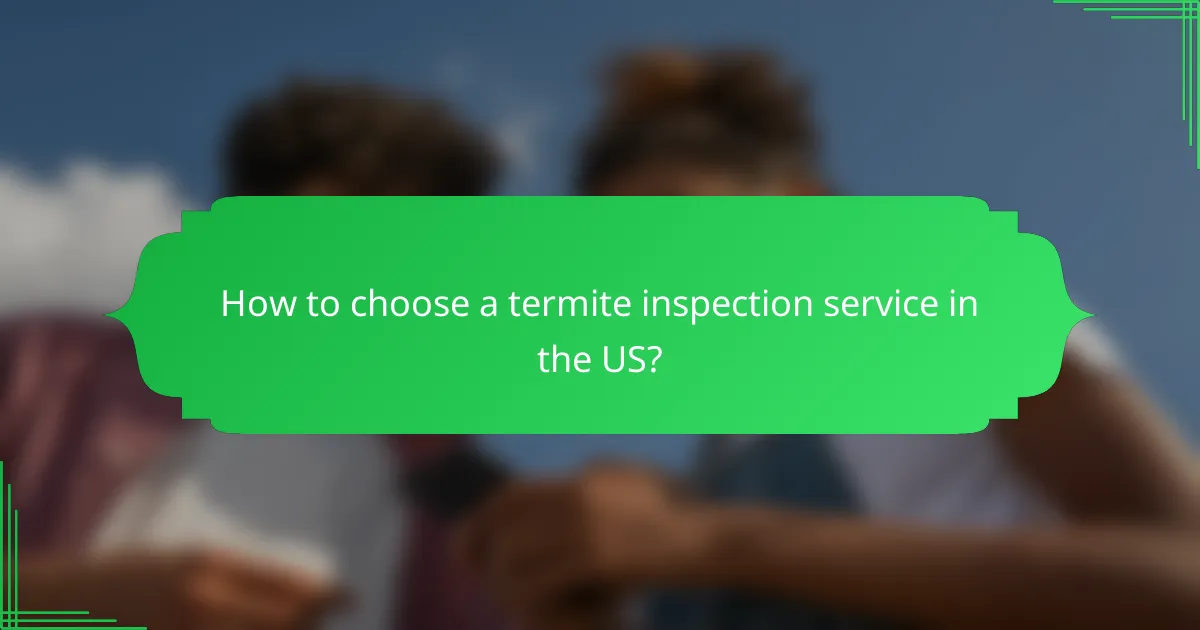
How to choose a termite inspection service in the US?
Choosing a termite inspection service in the US requires careful consideration of several factors, including the inspector’s qualifications, customer feedback, and the guarantees offered. Prioritize services that are licensed, insured, and have a solid reputation in your area.
Certification and experience of inspectors
Inspectors should hold relevant certifications, such as those from the National Pest Management Association (NPMA) or state-specific licensing boards. Experience is equally important; look for companies that have been in business for several years and have a track record of successful inspections.
Ask potential inspectors about their training and methods. A well-trained inspector will use a combination of visual inspections and advanced tools, such as moisture meters and infrared cameras, to identify termite activity effectively.
Customer reviews and ratings
Customer reviews provide insight into the quality of service offered by a termite inspection company. Check online platforms like Google, Yelp, or Angie’s List for ratings and testimonials from previous clients.
Pay attention to recurring themes in reviews, such as punctuality, thoroughness, and customer service. A company with consistently high ratings is likely to provide a reliable inspection experience.
Service guarantees and warranties
Many termite inspection services offer guarantees or warranties that protect your investment. These may include free re-inspections or treatment if termites are found after the inspection.
Review the terms of these guarantees carefully. A strong warranty can provide peace of mind, ensuring that you are covered if termite issues arise shortly after the inspection.

What is the cost of termite inspections and treatments?
The cost of termite inspections and treatments can vary significantly based on several factors, including location and the extent of the infestation. Generally, homeowners can expect to pay for both services to protect their property and investment effectively.
Average inspection costs
The average cost for a termite inspection typically ranges from $50 to $150, depending on the size of the property and the region. Some pest control companies may offer free inspections as part of their service package, particularly if you choose to proceed with treatment afterward.
It’s advisable to compare prices from multiple providers to ensure you receive a fair rate. Always check if the inspection includes a detailed report of findings and recommendations for treatment, as this can add value to the service.
Factors affecting treatment prices
Several factors influence the cost of termite treatment, including the type of treatment used, the severity of the infestation, and the size of the property. Chemical treatments, such as liquid termiticides, can range from a few hundred to several thousand dollars, while baiting systems may incur additional installation costs.
Location also plays a significant role; for example, urban areas may have higher service rates compared to rural regions. It’s essential to obtain detailed quotes that outline all potential costs involved in the treatment process.
Long-term savings from prevention
Investing in regular termite inspections and preventive treatments can lead to substantial long-term savings. Early detection and treatment can prevent extensive damage, which may cost thousands of dollars to repair. Homeowners who proactively manage termite risks often find that the initial inspection and treatment costs are far less than the potential repair bills.
Additionally, maintaining a termite-free environment can enhance property value and appeal, making it a wise investment for homeowners. Consider budgeting for annual inspections to safeguard your property and avoid costly surprises in the future.
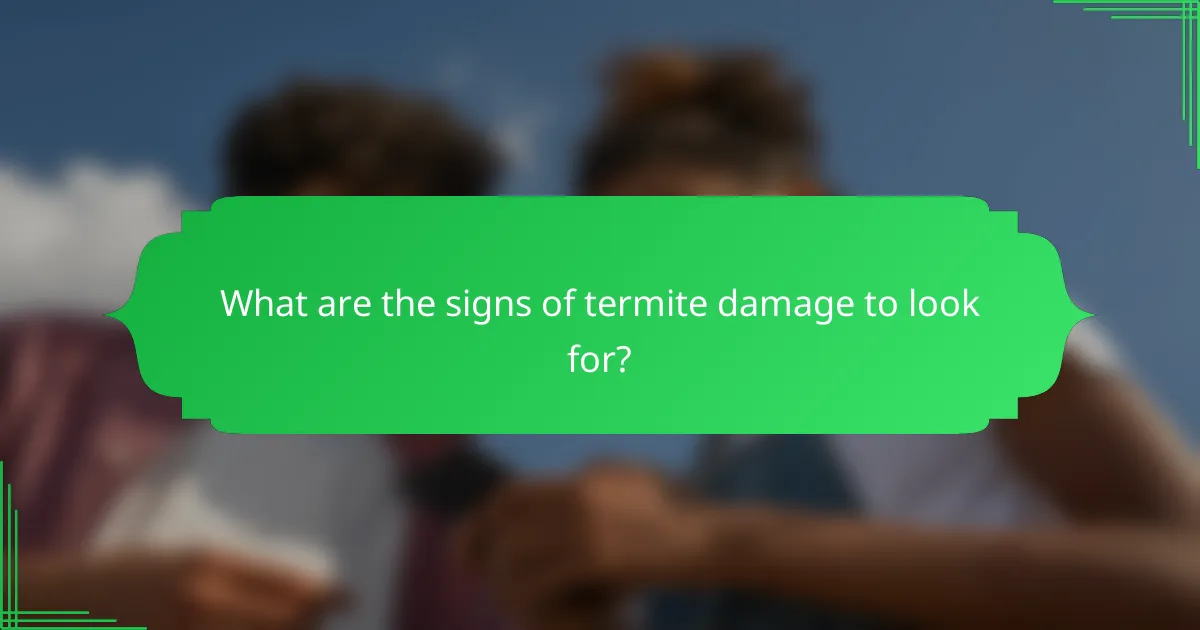
What are the signs of termite damage to look for?
Identifying signs of termite damage early can prevent significant structural issues and costly repairs. Key indicators include visible wood damage, mud tubes, and the presence of swarmers or discarded wings.
Visible wood damage
Visible wood damage is one of the most apparent signs of termite activity. Look for wood that appears hollowed out, has a honeycomb structure, or shows signs of frass, which are tiny droppings left by termites. If you notice any soft or crumbling wood, it may indicate a severe infestation.
Inspect areas like door frames, window sills, and wooden beams, especially in damp or humid environments, as termites thrive in such conditions. Regular inspections can help catch these signs early and mitigate further damage.
Signs of mud tubes
Mud tubes are protective tunnels that termites build to travel between their nests and food sources. These tubes are typically found on walls, foundations, or in crawl spaces and can be a clear indication of termite presence. They are made from soil, wood, and termite saliva, creating a hardened structure.
To check for mud tubes, look for pencil-sized tubes that may be brown or gray in color. If you find them, it’s crucial to take immediate action, as they signify an active infestation that needs professional treatment.
Swarmers and discarded wings
Swarmers are reproductive termites that leave their colonies to establish new ones. If you see winged insects indoors, especially during warm months, it may indicate a nearby termite colony. Discarded wings near windowsills or light fixtures are another telltale sign of a swarm.
Keep an eye out for these swarmers, as their presence often means that a colony is nearby and could be causing damage. If you notice swarmers or wings, consider scheduling a professional inspection to assess the situation and determine the best course of action.
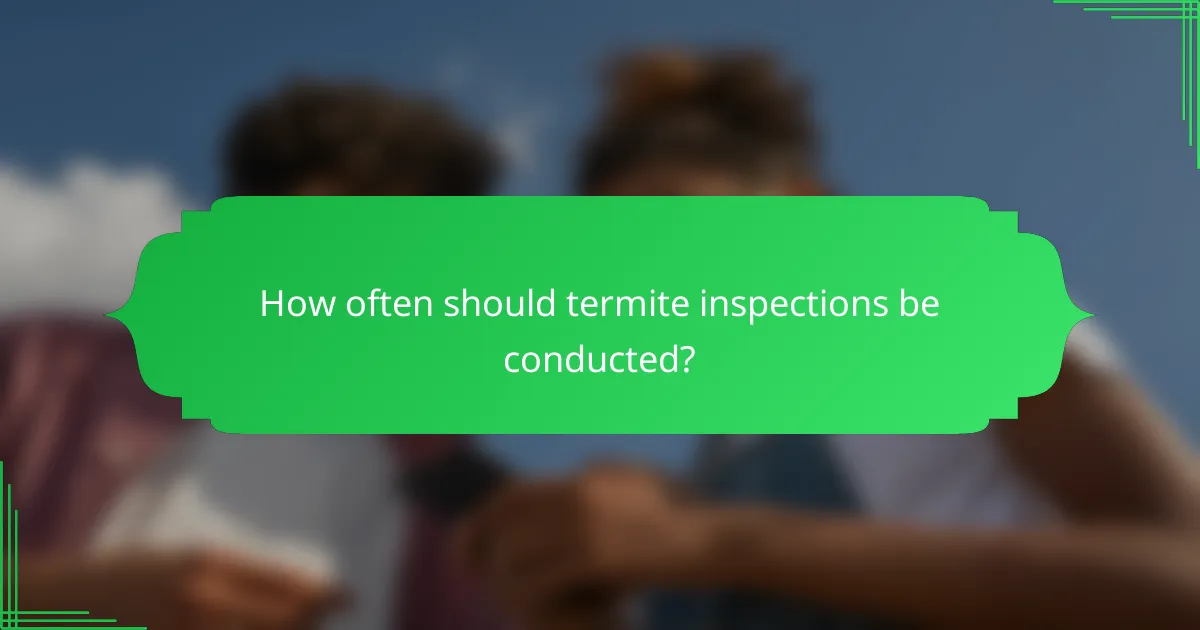
How often should termite inspections be conducted?
Termite inspections should generally be conducted at least once a year to effectively prevent damage. Regular inspections help identify potential infestations early, allowing for timely treatment and protection of your property.
Annual inspections recommended
Annual inspections are widely recommended as a standard practice for homeowners. This frequency allows for the detection of termite activity before it escalates into significant damage, which can be costly to repair.
During an annual inspection, a qualified pest control professional will assess both the interior and exterior of your home, checking for signs of termites and conducive conditions. This proactive approach can save you from extensive repairs and preserve your investment.
Frequency based on risk factors
The frequency of termite inspections may need to increase based on specific risk factors. Homes located in areas with high termite activity, such as those with warm climates or near wooded areas, may benefit from biannual inspections.
Other risk factors include the age of the home, previous termite infestations, and the presence of moisture issues. Homeowners should evaluate these factors and consult with pest control experts to determine the best inspection schedule for their situation.
Post-treatment inspection schedules
After treatment for a termite infestation, follow-up inspections are crucial to ensure the effectiveness of the treatment. Typically, a post-treatment inspection should occur within a few months after the initial treatment to confirm that termites have been eradicated.
Subsequent inspections may then revert to an annual schedule, but it is advisable to monitor the treated areas more closely for at least a year. Homeowners should maintain communication with their pest control provider to establish a suitable follow-up plan based on the treatment used and the specific conditions of their property.
